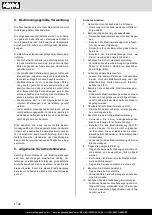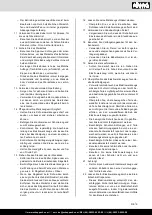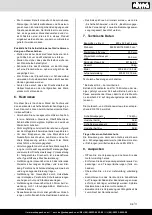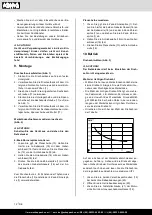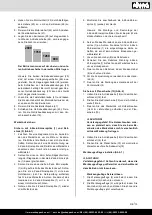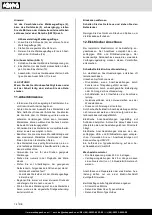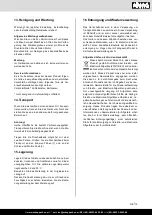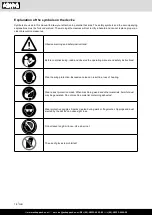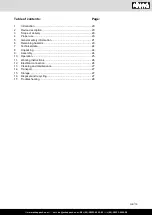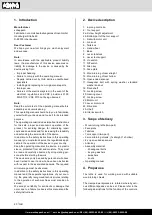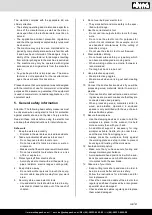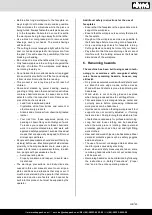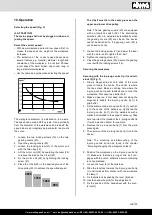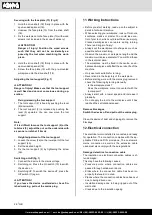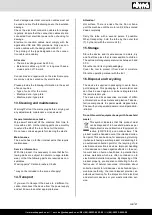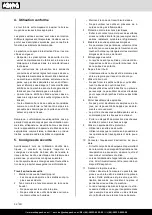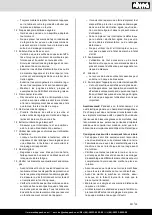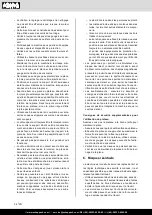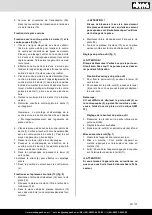
www.scheppach.com /
+(49)-08223-4002-99 /
+(49)-08223-4002-58
22 |
GB
21
Have your electric tool repaired by a qualified
electrician
– This electric tool conforms to the applicable
safety regulations. Repairs may only be per
-
formed by an electrician using original spare
parts. Otherwise accidents can occur.
22 Do not use the cable for purposes for which it is
not intended Do not use the cable to pull the plug
out of the outlet. Protect the cable from heat, oil
and sharp edges.
Warning!
This electric tool generates an electro-
magnetic field during operation. This field can impair
active or passive medical implants under certain
conditions. In order to prevent the risk of serious or
deadly injuries, we recommend that persons with
medical implants consult with their physician and the
manufacturer of the medical implant prior to operat-
ing the electric tool.
Operational Safety Instructions for the Wood
Turning Lathe
•
The machine may only be connected to a properly
earthed mains socket.
•
Familiarise yourself with the machine’s features and
wood-turning techniques before using the machine.
• Examine all workpieces for splits or knots. Glued
joints must set completely before turning.
•
Ensure that the workpiece is securely locked in
position and all attachments are secured.
•
Before turning the machine ON ensure that the
workpiece can rotate freely by rotating it by hand.
•
Keep your hands and fingers away from the rotat
-
ing workpiece.
•
Switch the machine OFF and wait until it has come
to a full stop before making any adjustments on the
workpiece, tailstock, or tool rest.
•
Maintenance, adjustment, calibration and cleaning
may only be performed with the motor turned off.
• The machine is designed for use with wood-turn-
ing chisels only.
•
Always store away the wood-turning chisels safely
before you leave the workplace.
• Do not run the lathe without its covers and guards
in place.
• Keep cutting tools sharp.
•
Use the lowest speed when starting a new work
-
piece.
•
Always stop the lathe at its slowest speed. If the
lathe is run so fast that it vibrates, there is a risk
that the workpiece will be thrown or the cutting tool
jerked from your hands.
• Do not allow cutting tools to bite into the workpiece.
The wood could be split or thrown from the lathe.
•
Always position the tool rest above the center line
of the lathe when shaping a piece of stock.
–
Keep the handle dry, clean and free of oil and
grease.
14 Pull the plug out of the outlet
– Never remove loose splinters, chips or jammed
wood pieces from the running saw blade.
– During non-use of the electric tool or prior to
maintenance and when replacing tools such as
saw blades, bits, milling heads.
–
When the saw blade is blocked due to abnormal
feed force during cutting, turn the machine off
and disconnect it from power supply. Remove
the work piece and ensure that the saw blade
runs free. Turn the machine on and start new
cutting operation with reduced feed force.
15
Do not leave a tool key inserted
–
Before switching on, make sure that keys and
adjusting tools are removed.
16 Avoid inadvertent starting
–
Make sure that the switch is switched off when
plugging the plug into an outlet.
17
Use extension cables for outdoors
–
Only use approved and appropriately identified
extension cables for use outdoors.
–
Only use cable reels in the unrolled state.
18
Remain attentive
–
Pay attention to what you are doing. Remain
sensible when working. Do not use the electric
tool when you are distracted.
19 Check the electric tool for potential damage
– Protective devices and other parts must be
carefully inspected to ensure that they are fault-
free and function as intended prior to continued
use of the electric tool.
– Check whether the moving parts function fault-
lessly and do not jam or whether parts are dam
-
aged. All parts must be correctly mounted and
all conditions must be fulfilled to ensure fault-
free operation of the electric tool.
–
The moving protective hood may not be fixed
in the open position.
– Damaged protective devices and parts must be
properly repaired or replaced by a recognised
workshop, insofar as nothing different is spec
-
ified in the operating manual.
– Damaged switches must be replaced at a cus-
tomer service workshop.
–
Do not use any faulty or damaged connection
cables.
–
Do not use any electric tool on which the switch
cannot be switched on and off.
20 Attention!
– The use of other insertion tools and other ac-
cessories can entail a risk of injury.

